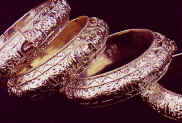|
Tepuk Sireh
| Gold
During the 17th and 18th centuries, the craft of making gold ornaments began to develop due to the patronage of the royal households of Kelantan, Kedah, Perak and Pahang. During this time, the most common item made for the Malay aristocracy was the pending or belt buckle, which was embellished with precious stones. |
|
| Another item among the royal regalia was the tobacco box as the habit of chewing tobacco was popular at that time. Gold was also used for various parts of the keris, a short Malay dagger. The unique kerosong consisted of three brooches with which women pinned their blouses worn with the sarong. Among the other personal ornamentation items were the gold and silver hairpin called cucuk sanggul and was much sought after by wealthy Malay women as it was used to secure their hair in a bun. ‘Nyonya’, women from Malay Chinese mixed marriages, Indian and Portuguese women also adopted this practice. |
| Repousse and granulation were the two main methods of working in gold by Malay craftsmen, and they still remain popular today. Repousse involves raising designs upon a thin sheet of gold by hammering from the back while granulation is a technique where grains of gold are placed on a gold sheet and soldered together, thus creating an ornamental design. Another method of Malay goldsmithing is tinting the gold red or orange by immersing the object in chemicals. Today, Malay gold jewelry is mostly in the form of anklets, bracelets, rings, necklaces, waist buckles, pendants, earrings, and breast ornaments. |
|
|
Silver Silversmithing also has a long history in the Malay peninsula, though not indigenous. During the zenith of Buddhist-Hindu kingdoms like SriVijaya and Majapahit in the region, silver objects were brought into the Malay Peninsula by foreign traders. Thereafter Malay gold artisans began to work in silver from silver ingots and bars. |
| Malay silverware is known for its intricate and delicate designs. The decoration or design is mostly produced by repousse, filigree work and neillowork. Items unique to silver are pillow ends, belt buckles, mat corners, stoppers for water vessels, keris sheaths and tobacco boxes. Pillow ends and tobacco boxes are usually decorated with cloud patterns or vegetal motifs. The states of Kelantan and Terengganu produce the best silverware in the country but the craft of traditional silversmithing is a dying one. |
|
| Brass The art of casting brassware in Malaysia was first practiced in Kelantan and Terengganu about the turn of the 17th century. Two factors accounted for this region being the birthplace of brass working. Firstly, the craft of making brassware had flourished in Thailand since 3,000 BC. The region’s close proximity to Thailand provided opportunities for craftsmen to learn the art. Secondly, substantial amounts of copper and zinc discovered in the area allowed a ready supply of raw materials. The brass industry grew because of demand from ordinary villagers, who could not afford items of gold and silver. From this region, brassware began to spread to other parts of Peninsula Malaya. In the early days, copper objects ranged from household, decorative and ceremonial items to canons cast from brass. However, the most celebrated brass tem in Malay society is the tepuk sireh, a tray which is used to hold the ingredients of the betel quid. Certain musical instruments such as gongs used in the gamelan orchestra are also made of brass. |
| Other popular items include flower vases, candleholders, incense burners, perfume sprinklers, kettles, serving trays, cooking pots and heavy-duty buckets. Most brassware are divided into two types: yellow brass for functional items and white brass for decorative items. Using the lost wax method of casting brassware, the process begins by making a sculpture of the item to be cast. The sculpture, made from clay or carved out of wood, is alternatively dipped in hot wax and cold water until the desired thickness of the wax is acquired. The wax shell is touched up and coated with slurry. The slurry-covered sculpture, which has a tiny outlet, is then heated in a furnace to melt the wax, which drains out through the outlet. Molten brass is then poured into the slurry mold. After the brass has cooled and solidified, the slurry mold is broken off. Items that have been cast separately are then soldered. The completed item is then polished. |
Kuala Lumpur & Handicrafts Tours  Discover Malaysia States of Malaysia History Monarch Government History People Culture Festivals Holidays Handicrafts Cuisine Weather Golfing FAQ |
|





